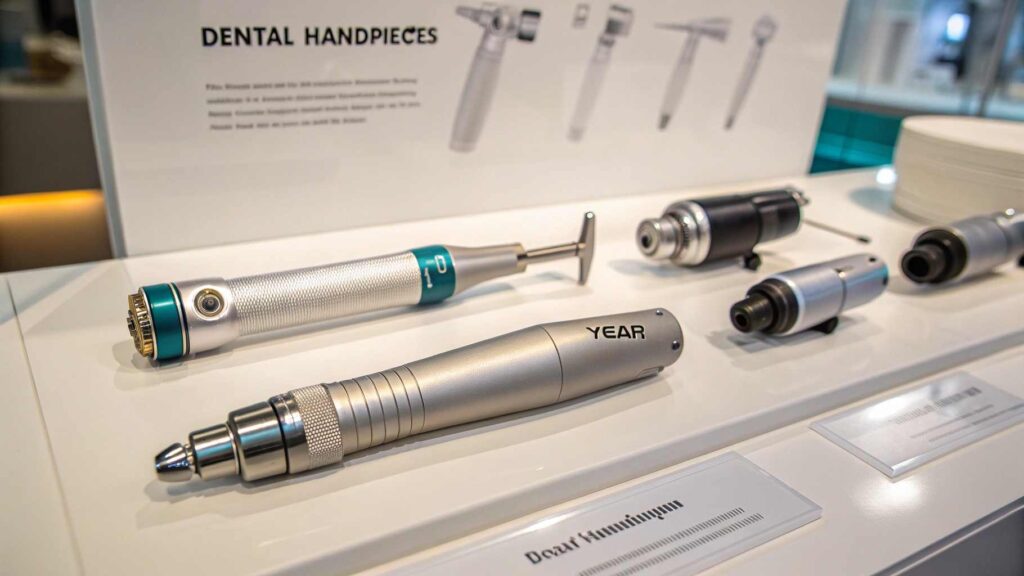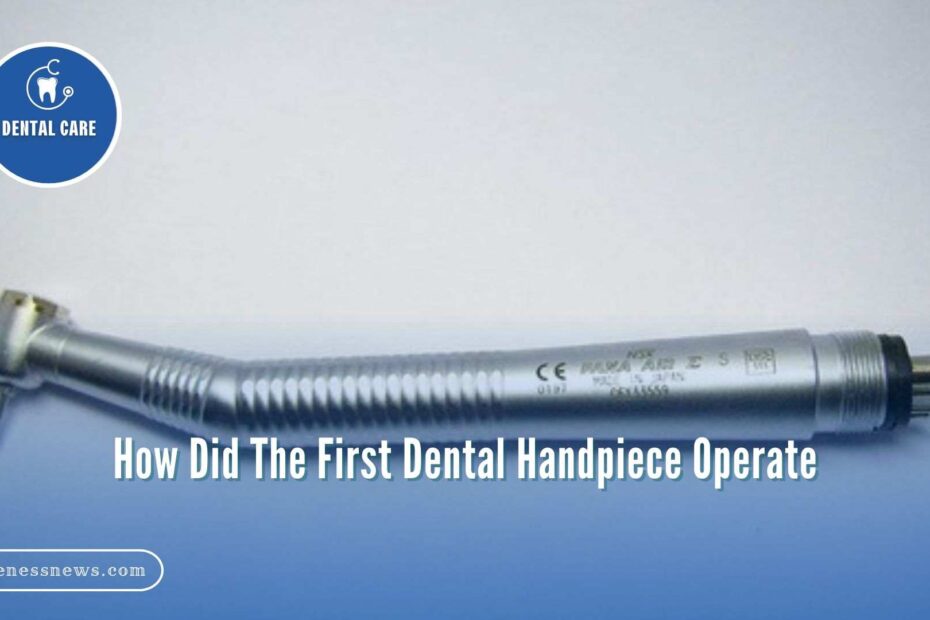The first dental handpiece operated using manual or foot-powered motion, transferring energy through belts and pulleys to rotate the drill. It allowed basic cutting but lacked speed and precision compared to modern tools.
Stay tuned with us as we dive into the fascinating story of early dental tools! Up next, we’ll explore how the first dental handpiece operated and what made it a game-changer in dental history. You won’t want to miss it!
Why was the Invention of the Dental Handpiece Revolutionary?
Before we dive into mechanics, it’s important to understand the why behind the innovation. Dentistry has always been a field that balanced precision with patient care. But early dental procedures, particularly during the 18th and 19th centuries, were extremely rudimentary. Cavities were removed by brute force using chisels, files, or even pocket knives.
Not only was this painful and traumatic for patients, but it also made dental work imprecise. There was a clear need for a mechanized tool that could allow dentists to work with more control, speed, and accuracy.
For example, understanding how to heal dental cavitations naturally was impossible in that era, leading to long-term complications.
The Birth of the First Dental Handpiece:
Inventor Spotlight: Dr. George F. Green
In 1871, American dentist Dr. George F. Green patented the first electric dental drill. But this milestone didn’t come out of nowhere—it was built on decades of experimentation with mechanical devices.
The Mechanical Predecessors
Before electric drills, dentists used manual or treadle-powered handpieces. Some of the earliest versions were inspired by the foot-pedal sewing machine, using rotary motion transmitted through a system of pulleys or cords to a hand-held drill.
- Treadle-powered handpieces were operated by the dentist’s foot pumping up and down.
- Crank-style models required hand operation, limiting the dentist’s control.
- Bow drills borrowed from woodworking and early surgical tools, also played a role in shaping the early concept of rotary dental devices.
How Did the First Dental Handpiece Operate?
The operation of the first dental handpieces was based on simple mechanical engineering principles. Here’s a breakdown of how they functioned:
Source of Power: Manual or Foot-Driven:
These early handpieces had no motor. Instead, power came from physical movement:
- Manual handpieces involved turning a crank or wheel by hand.
- Treadle-powered handpieces allowed for continuous rotation using foot motion, much like early bicycles.
This motion turned a belt or cord that transferred rotational energy to the dental bur.
Transmission System: Belts, Pulleys, and Cords:
A system of cords and pulleys connected the drive mechanism (foot pedal or crank) to the drill head. This is what enabled rotational motion at the bur.
The biggest challenge? Maintaining consistent speed and torque. Any irregular motion from the foot or hand caused fluctuations, making precision difficult.
Want to understand modern comfort techniques? Check out how to use dental wax for a broken tooth for a simple home remedy today.
Rotational Speed and Efficiency:
The earliest dental drills could only achieve a few hundred revolutions per minute (RPM)—a far cry from the 400,000+ RPM we see in modern high-speed drills. These slow speeds limited how efficiently and cleanly decay could be removed.
What Materials Were Used?
The first dental handpieces were crafted with durable metal bodies, typically steel or brass. The drill burs were forged from hardened carbon steel, though they dulled quickly compared to today’s diamond- or carbide-tipped burs.
There were no water sprays or cooling systems, which often resulted in heat generation and patient discomfort during longer procedures. Compare this to today’s practice of how long does Halcion last for dental work to manage discomfort during longer sessions.
Pain Management: Anesthesia Was Rare
One of the most brutal aspects of early dentistry was the lack of anesthesia. The first dental handpieces, despite being revolutionary, still caused pain. Patients often endured procedures without any numbing agents until the late 19th century, when ether and nitrous oxide became more common.
This limitation made speed and efficiency even more important—dentists had to work quickly, and patients had to grit their teeth through the ordeal.
Today, solutions like tooth-colored fillings at Sharyland Dental make for a vastly improved patient experience.
Major Milestones in Dental Handpiece Evolution:

To appreciate the progress, it’s worth understanding how dental handpieces evolved over time:
| Year | Innovation | Details |
| 1790 | Foot-powered dental drill | Modeled after the spinning wheel; hand- or foot-operated |
| 1871 | Green’s Electric Drill | First dental handpiece powered by electricity |
| 1940s | Belt-driven handpieces | Increased speed and torque, still bulky |
| 1950s | Air-turbine handpieces | Game-changing speed with reduced weight |
| 1960s+ | Water-cooled and fiber-optic models | Improved comfort, visibility, and safety |
| Today | Electric and air-driven hybrids | Lightweight, precise, and digitally controlled |
Air Turbine Revolution: A Closer Look:
The introduction of the air turbine handpiece in the 1950s was arguably the most significant development since Dr. Green’s invention. By using compressed air to rotate the bur, dentists could:
- Achieve speeds over 300,000 RPM
- Minimize vibrations
- Improve cutting precision
- Reduce patient discomfort
Today’s modern dental offices rely on these tools to perform fillings, crowns, cosmetic shaping, and even surgical procedures with unmatched accuracy.
Ever wonder how screwless dental implants work? That level of sophistication was only possible due to earlier breakthroughs like the handpiece.
How the First Handpiece Changed Dentistry?
Despite its limitations, the first dental handpiece represented a paradigm shift:
- Standardization of dental procedures: Allowed more predictable treatment outcomes.
- Expanded dental training: Schools began teaching handpiece use as a core skill.
- Increased patient access: More efficient treatment led to more affordable dental care.
Wondering how to sell a dental practice quickly? Innovations like these can significantly boost practice value.
A Dentist’s Perspective: Then vs. Now
Let’s compare the two eras to show just how far we’ve come:
| Aspect | Early Handpieces | Modern Handpieces |
| Power Source | Manual or electric crank | Compressed air or electric motor |
| Speed | 100–800 RPM | 200,000–500,000+ RPM |
| Cooling System | None | Water spray and cooling jet |
| Noise | Loud mechanical grinding | Whisper-quiet models available |
| Precision | Low | High with micromotor control |
| Patient Comfort | Minimal | Significantly improved |
Curious about industry roles? Discover how to become a dental ceramist and enter a highly skilled dental specialty.
The Future of Dental Handpieces:
We’ve come a long way, but the innovation continues. Emerging trends include:
- Laser handpieces: For ultra-precise, non-invasive cavity removal.
- Smart handpieces: Featuring sensors and AI for pressure and torque control.
- Cordless and ergonomic designs: For greater freedom and less fatigue.
- Eco-friendly materials: Reducing sterilization waste and carbon footprint.
Experiencing dizziness? Learn how long dental vertigo lasts—it may be linked to jaw or nerve issues post-treatment.
FAQ’s
1. Who invented the first air-turbine dental handpiece and when?
While Dr. George F. Green is credited with the electric dental drill, the first air-turbine handpiece was developed by John Borden in the 1950s. His “Airotor” dramatically increased speed and efficiency, making it a major leap forward in dental technology.
2. How do modern dental handpieces prevent cross-contamination?
Modern handpieces often feature anti-retraction valves and are autoclavable, meaning they can be sterilized at high temperatures. These advancements help prevent bacteria from being sucked back into the device, reducing the risk of infection.
3. Are there different types of dental handpieces used for different procedures?
Yes, there are primarily two types:
- High-speed handpieces for cutting enamel and prepping teeth.
- Low-speed handpieces for polishing, refining, and finishing.
Some procedures may also use specialized surgical or endodontic handpieces with distinct designs and torque settings.
4. What role does torque play in the performance of a dental handpiece?
Torque refers to the rotational force of the handpiece. Higher torque allows for efficient cutting with less pressure, reducing stress on both the tooth and the dentist’s hand. Modern electric handpieces offer more consistent torque than older air-driven models.
5. How often do dental professionals need to maintain or replace handpieces?
Dental handpieces require routine maintenance, such as lubrication and sterilization, after every use. Depending on usage frequency and quality, a handpiece may need replacement every 6 months to 2 years. Regular maintenance can significantly extend its life.
Conclusion:
The invention of the dental handpiece changed dentistry forever. From slow, painful tools to today’s high-speed, gentle drills, it made dental care faster, safer, and more comfortable. As technology keeps improving, patients can expect even better treatment with less pain and more precision in the years to come.
Also Read:
